|
|
|
Sort Order |
|
|
|
Items / Page
|
|
|
|
|
|
|
| Srl | Item |
| 1 |
ID:
130422
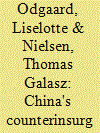

|
|
|
|
|
| Publication |
2014.
|
| Summary/Abstract |
China's counterinsurgency strategy in Tibet and Xinjiang relies heavily on hard power and imposition. Well-functioning vertical coordination in the security sector of China's political system and assimilationist nationality dynamics combine to favour the use of force against ethnic groups that do not accept the political legitimacy of China's Communist Party. Transnational links contribute to China's difficulties with implementing counterinsurgency in Tibet and help China implement its strategy in Xinjiang. Development strategies aimed at improving living standards are crowded out due to a lack of horizontal coordination between civilian and security agencies and a bias towards unitary nation-building in Chinese nationalism.
|
|
|
|
|
|
|
|
|
|
|
|
|
|
|
|
| 2 |
ID:
131647
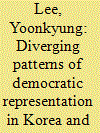

|
|
|
|
|
| Publication |
2014.
|
| Summary/Abstract |
This paper explains the difference between Korea's vocal movements and feeble parties versus Taiwan's stable parties and dependent movements from the political dynamics formed under the authoritarian state. Taiwan's party-based authoritarianism provided ground for party development but not for independent social movements. Korea's personal dictatorship was inimical to party development but engendered a contentious movement sector.
|
|
|
|
|
|
|
|
|
|
|
|
|
|
|
|
| 3 |
ID:
124578
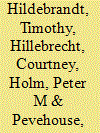

|
|
|
|
|
| Publication |
2013.
|
| Summary/Abstract |
The debate around humanitarian intervention and the responsibility to protect generally concerns a collective action problem on the international level: motivating states to participate in a multilateral coalition to stop a mass atrocity. This debate presupposes that states enjoy a domestic consensus about their rights and responsibilities to intervene. This article reconsiders this assumption and examines the sources of domestic political will for intervention, particularly the role of partisanship, ideology, and public opinion on Congressional members' willingness to support US intervention for humanitarian purposes. We analyze several Congressional votes relevant to four episodes of US humanitarian intervention: Somalia, Haiti, Bosnia, and Kosovo. We find that public support for humanitarian intervention increases Congressional support and that other political demands, primarily partisanship and ideological distance from the president, often trump the normative exigencies of intervention. Our findings shed light on the domestic political dynamics behind humanitarian intervention and can help explain why some recent humanitarian missions have proceeded without seeking Congressional approval.
|
|
|
|
|
|
|
|
|
|
|
|
|
|
|
|
| 4 |
ID:
131950


|
|
|
|
|
| Publication |
2014.
|
| Summary/Abstract |
In a novel approach to studying political mobilization among ethnic Tibetans in China, this article addresses two key questions. First, considering the Chinese state's repressive policies towards Tibetan Buddhism, what role does religion play in fomenting Tibetan political resistance? Second, what implications can be drawn from the changing ethnic demography in Tibet about the conflict behaviour of Tibetans? Using various GIS-referenced data, this article specifically examines the 2008 Tibetan protest movements in China. The main results of our analysis indicate that the spread and frequency of protests in ethnic Tibetan areas are significantly associated with the number of officially registered Tibetan Buddhist sites, as well as the historical dominance of particular types of Tibetan religious sects. Furthermore, our analysis shows that the effect of Han Chinese settlement on Tibetan political activism is more controversial than previously though
|
|
|
|
|
|
|
|
|
|
|
|
|
|
|
|
| 5 |
ID:
132413
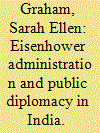

|
|
|
|
|
| Publication |
2014.
|
| Summary/Abstract |
The United States-India relationship was fraught with misapprehension and ideological disagreement during the 1950s. Public diplomacy provides a valuable context for examining these dynamics. This analysis assesses the planning, deployment, and reception of American public diplomacy to India under President Dwight Eisenhower, a period encompassing Washington's 1954 alliance with Pakistan and economic aid to India in 1957-1958. Public diplomacy reflects the Administration's difficulty in clarifying its interests in India. The rhetorical and moralising approach of India's leadership, and their prominence in the global non-aligned movement, contributed greatly to this ambivalence. Public diplomacy planning highlights Washington's difficulties in confronting India's identity in world politics; it struggled to craft messages on racial attitudes, consumerism, and Communism, whilst Soviet public diplomacy gave strong competition throughout the period. At the same time, several aspects of American public diplomacy resonated with Indian audiences, indicating that there was the possibility of a closer American relationship with India had Washington taken a different high policy approach to the region.
|
|
|
|
|
|
|
|
|
|
|
|
|
|
|
|
| 6 |
ID:
124462


|
|
|
|
|
| Publication |
2013.
|
| Summary/Abstract |
The 1960s in Afghanistan's history were marked by the emergence of a number of political parties, from monarchist to radical left and right. They played an important role in the social, cultural and political dynamics of the time and even the future of the country. This paper explores how political parties emerged in a country which was characterized as a tribal-peasant society with only a very small number of educated people. It also discusses why the monarch would not sign the Political Parties' Bill and how this influenced Afghanistan's political culture and led to the radicalization of the political parties. In addition, it examines how the anti-government and radical political parties managed to mobilize people and dominate the political scene while the pro-government and nationalist parties had little influence.
|
|
|
|
|
|
|
|
|
|
|
|
|
|
|
|
| 7 |
ID:
126660
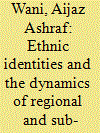

|
|
|
|
|
| Publication |
2013.
|
| Summary/Abstract |
The concept of regional and sub-regional identity as well as regional autonomy has captured the stage of Social Science. The regional autonomy aspirations and the sense of regional and sub-regional identity have offered a new dimension to the assertiveness of ethnic group. Regional identity demands in South and Southeast Asian societies have followed a uniform pattern. These regional autonomy demands evolved over a large span of time may be located in specific geographical and environmental spaces. At one level, these demands remained humane and inclusive, incorporating and reflecting broader human and universal values. At the other level, they acquired the traits of particularism which in the later stages of building multi-cultural and multi-ethnic nation states posed many problems. The plurality of politics is the hallmark of Jammu and Kashmir (J&K) State, and this polarity is essentially the result of cultural diversities that criss-cross the geographical and cultural landscape of Kashmir. The J&K State is not only a conglomerate of three distinct regions - Jammu, Kashmir, and Ladakh - but there are also regions within regions marked off from one another by geography, culture, and history. The politics of regional and sub-regionalism based on region, religion, caste, ethnicity, and so on continues to be stubbornly informed by their respective histories and cultures - thus the resistance against hegemony and the demand for sub-regional autonomies and Hill Development Councils. This article attempts at, looking into the dynamics of these assertions, its impact on the politics of the state, and to delineate the role of different socio-political and historical forces in shaping regional and sub-regional assertions in J&K without, however, suppressing the relative significance of different identity markers.
|
|
|
|
|
|
|
|
|
|
|
|
|
|
|
|
| 8 |
ID:
126661
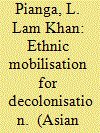

|
|
|
|
|
| Publication |
2013.
|
| Summary/Abstract |
This article attempts to communicate the methodological tension between subjectivity and objectivity by recording the aspiration of communities who are problematised both by colonialism and the modern nation-state. It highlights how colonial policy and practice contribute to the postcolonial imbroglio in Northeast India. It delineates how British colonial cartography always gave priority to 'administrative convenience' in the demarcation of boundaries, resulting in the division of ethnic community. It argues that Northeast India and the Indo-Burma borderland are not yet decolonised, as the government of India, without any rearrangement or alteration, adopts the colonial administrative boundaries, which divided ethnic communities. Neither the State Reorganisation Act (1956) nor the North-Eastern Areas (Reorganisation) Act (1971) fulfilled the aspiration of the segmented communities in the northeast, as they did in the mainland. The article also argues that the responses of the government of India towards the problems in Northeast India react to the manifested symptoms of the deep-rooted political problem rather than getting to the crux of the problem to find a solution.
|
|
|
|
|
|
|
|
|
|
|
|
|
|
|
|
| 9 |
ID:
132947
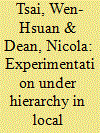

|
|
|
|
|
| Publication |
2014.
|
| Summary/Abstract |
Reforms carried out by the Chinese Communist Party (CCP) have long followed a traditional model of "experimentation under hierarchy." This article will attempt to develop this model further by building a framework to illustrate the influence of both the political dynamics of hierarchical central-local relations and local economic circumstances in the introduction of large-scale political reforms. The initiation and expansion of "experimental points" are only permitted in those select few provinces with both favourable political and economic local conditions, allowing the CCP to minimize risk and make informed decisions regarding possibilities for nationwide reform. This article proposes that the hierarchical interaction of central and local political elites, and in particular provincial secretaries, can explain the extent of reforms, whereas the type of reform is linked to distinct provincial economic conditions and the provincial secretary's interpretation of provincial priorities. Put succinctly, the CCP's model of political reform can be specifically characterized as "experimentation under hierarchy in local conditions." This article presents a detailed discussion of both the political and economic considerations inherent in this concept, and provides examples of reform programmes in Guangdong and Sichuan to illustrate the model in practice.
|
|
|
|
|
|
|
|
|
|
|
|
|
|
|
|
| 10 |
ID:
142416
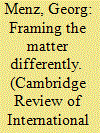

|
|
|
|
|
| Summary/Abstract |
Most of the scholarly literature on European Union immigration policymaking has emphasized the predominance of governmental actors. The major changes entailed in the 2009 Lisbon Treaty, however, imply a significant increase in supranationalism and necessitate rethinking earlier conclusions. Exploring the concomitant rise of policy entrepreneurship traits in the actions taken by the European Commission, this article emphasizes the role of discourse structuration in managing policymaking in a contested and controversial policy domain. The Commission is thus gaining more influence and importance, partially facilitated by institutional changes in the Lisbon Treaty, but mainly due to astute policy entrepreneurship in facilitating consensus. Framing problems in a fashion that maximizes potential agreement by member state governments facilitates political agreement regarding potentially divisive policy proposals. Discursive elements are created and circulated that are designed to appeal, render political implementation at the national level unproblematic and, in some cases, are deliberately bipartisan in nature. Thus, great rhetorical emphasis is placed on linking policy with competitiveness, economic growth and the Europe 2020 agenda to appeal to centre-right concerns, but in the case of temporary migration links are also constructed to centre-left issues, including enhancing migrant rights, avoiding exploitation and creating benefits for sending countries. Empirically, the article focuses on the politics surrounding the genesis of the directive on highly qualified migrant workers (the so-called Blue Card) and the migrant seasonal workers directive.
|
|
|
|
|
|
|
|
|
|
|
|
|
|
|
|
| 11 |
ID:
131951
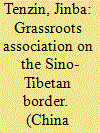

|
|
|
|
|
| Publication |
2014.
|
| Summary/Abstract |
This article investigates the role of the Moluo Tourism Association in Suopo township, Danba county, Sichuan. It examines its organization, internal structure and objectives, and explores the concerns of Tibetan elites and villagers and their strategies for advancing their political and other goals in an officially sanctioned framework. The research shows that the association resembles a "state-led civil society" as its membership and agendas exhibit the strong will of the local state; nevertheless, it still manages to carve a space for expressing negative opinions towards the local authorities, pursuing the "Eastern Queendom" cause and following its own agendas. The dynamic and nuanced interactions between the association and township show that state-society relations in China are situated in a complex and convoluted landscape which has not yet been fully explored in the China field. Furthermore, the article brings to light the divergent interests and positions of the association members as well as the heterogeneity of Suopo society proper. It concludes with a brief discussion of the prospects for an enhanced engagement of ethnic research with broader China studies.
|
|
|
|
|
|
|
|
|
|
|
|
|
|
|
|
| 12 |
ID:
129682
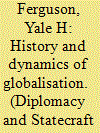

|
|
|
|
|
| Publication |
2014.
|
| Summary/Abstract |
Globalisation involves geographically wider transaction networks and has multiple interrelated dimensions. The globalisation process has geographical scope, volume and density of transactions, and a direction and pace of change. Globalization has a long history, and the local and the global have almost continuously interacted. Most forward changes have been incremental, and there have also been major reversals or almost complete system-breakdowns. There are numerous drivers of globalization of different types, persons, and groups with varying motives, and anonymous drivers like technology, weather, and disease. The article devotes most attention to a review of selected patterns and trends in contemporary globalisation These are climate change; demographic trends, income inequality, and migration; security concerns, technology, and peacekeeping; competing ideologies; the global economy, equities, trade, banking reform, and tax havens; and shifting power relationships among the United States, Europe, China, Japan, and Emerging Markets.
|
|
|
|
|
|
|
|
|
|
|
|
|
|
|
|
| 13 |
ID:
133776
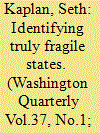

|
|
|
|
|
| Publication |
2014.
|
| Summary/Abstract |
That the Arab Spring caught the world off guard is hardly surprising. Interpreting overt stability as a reflection of fundamental strength or resiliency has often set the international community up for surprise. Few forecast the dissolution of the Soviet Union, for example; far too few in Washington anticipated what would follow the invasion of Iraq. These are reminders that apparent stability can be little more than an illusion.
|
|
|
|
|
|
|
|
|
|
|
|
|
|
|
|
| 14 |
ID:
101027
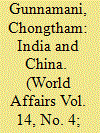

|
|
|
|
|
| Publication |
2010.
|
| Summary/Abstract |
The reconfiguration of Southeast Asia (SEA) is explored, with respect to the emergence of India and the rise of China, in shaping the region as a multipolar political space, focusing on understanding the fluidity of SEA as an economic and political source of regional power, especially in the aftermath of the diffusion of bipolar political dominance in the region with the end of the cold war.
An examination of the political economy and the formation of regional powers reveals the nature of this fluidity and its transformation. The region will play a large role in determining the futures of India and China where not only their impact on the region, but also its impact on them, will contribute to the ways, in which the two nations evolve,
|
|
|
|
|
|
|
|
|
|
|
|
|
|
|
|
| 15 |
ID:
133903
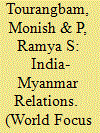

|
|
|
|
|
| Publication |
2014.
|
| Summary/Abstract |
In recent times, few other events in world politics has garnered the attention of practitioners and scholars as the relative opening of Myanmar has done, erstwhile under the iron fist rule of the military. While countries increasingly make a beeline to engage resource-rich and strategically located Myanmar, several challenges remain, both internal and external in nature. As India envisions a more comprehensive and more broad-based relationship with Myanmar in its new avatar, New Delhi has to juggle amidst challenges emerging out of Myanmar's own political dynamics in addition to India's security concerns, its economic ambitions and the strategic dimensions of an emerging balance of power game in Asia.
|
|
|
|
|
|
|
|
|
|
|
|
|
|
|
|
| 16 |
ID:
129575
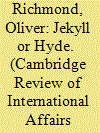

|
|
|
|
|
| Publication |
2014.
|
| Summary/Abstract |
As a response to the dynamics of state formation, statebuilding has not created model states in the last twenty years as was intended. Instead, the states that have emerged around the world are heavily contextually contingent. This is despite international attempts to shape them according to a common pattern, dominated by neoliberal models of statehood. This raises the question of what kind of hybrid states are actually forming as a result of the encounter between international statebuilding and local political dynamics? This article argues that international statebuilding aims to create neoliberal states and treats local political dynamics as dysfunctional. Yet from a local perspective the limitations of the statebuilding model are also apparent, as is the need for any locally legitimate state to be grounded in its context.
|
|
|
|
|
|
|
|
|
|
|
|
|
|
|
|
| 17 |
ID:
133601
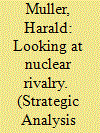

|
|
|
|
|
| Publication |
2014.
|
| Summary/Abstract |
The 100th anniversary of World War I is a reminder of the risks of great power politics. The current dynamics of world politics rest on the relations among the US, China, Russia and India, and their interlocking relations with friends and enemies in a region that extends from the Gulf to the Japanese archipelago. A naval and nuclear arms race is underway that reflects these complex relationships. One of the numerous disputes could spread conflict across the whole region. This risk includes the nuclear factor. A three-pronged effort including political detente, arms control and nuclear disarmament is needed to defuse these dangers, which will otherwise continue to grow.
|
|
|
|
|
|
|
|
|
|
|
|
|
|
|
|
| 18 |
ID:
170617
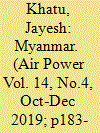

|
|
|
| 19 |
ID:
128078
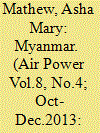

|
|
|
|
|
| Publication |
2013.
|
| Summary/Abstract |
The year 2010 witnessed Myanmar setting out on an elaborate course to put an end to its seclusion and work towards integrating itself with the global system. For years together Myanmar had been slapped with embargoes from the West and had undergone various domestic challenges that have led to chaos within the country as well as hampered relations with neighbouring countries. The current leadership of Myanmar, hence, has a long way to go in order to bring about political stability which the country looks to achieve. It definitely goes without saying that political and economic stability go hand in hand. Myanmar is yet to realize its potential in term of its natural resources and minerals, which if tapped into can generate a lot of wealth, in turn promising better prospects for the country as well as the region.
|
|
|
|
|
|
|
|
|
|
|
|
|
|
|
|
| 20 |
ID:
131809
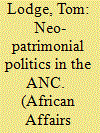

|
|
|
|
|
| Publication |
2014.
|
| Summary/Abstract |
Following Jacob Zuma's ascension to the presidency in South Africa, the African National Congress (ANC) has been dogged by rumours of escalating corruption and the personalization of power. This article documents these trends and explores three ways of understanding neo-patrimonialism in South Africa's ruling party. First, the article addresses the possibility that such political habits have a long history within the ANC but were restricted during its years in exile and have begun to resurface now that the armed struggle is over. Second, it considers explanations that relate to the party's historical ties to criminal networks and pressures arising from the transition to majority rule and contemporary electoral politics. Finally, the article investigates whether neo-patrimonialism is a reflection of broader tendencies within South African political and economic life. All three factors are found to have played a role in the rise of neo-patrimonial politics, and it is the confluence of these trends that explains why these dynamics have taken such a strong hold on the party.
|
|
|
|
|
|
|
|
|
|
|
|
|
|
|
|
|
|
|
|
|